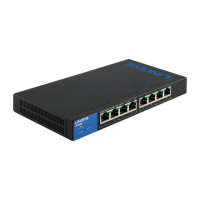31
Table of Contents
Linksys
31
Table of Contents
Linksys
If at any time during the connectivity an attached PD requires more power
from the device than the configured allocation allows (no matter if the device
is in Class Limit or Port Limit mode), the device does the following:
• Maintains the up/down status of the PoE port link
• Turns off power delivery to the PoE port
• Logs the reason for turning off power
Feature Configuration
The Feature Configuration page enables selecting either the Port Limit or
Class Limit PoE mode.
These settings are entered in advance. When the PD actually connects
and is consuming power, it might consume much less than the maximum
power allowed.
Output power is disabled during power-on reboot, initialization, and system
configuration to ensure that PDs are not damaged.
To configure PoE on the device and monitor current power usage:
STEP 1 Click Configuration > Port Management > PoE > Feature Configuration.
STEP 2 Enter the values for the following fields:
• Power Mode—Select one of the following options:
• Port Limit—The maximum power limit per each port is configured by the
user.
• Class Limit—The maximum power limit per port is determined by the
class of the device, which results from the Classification stage.
NOTE:
When you change from Port Limit to Class Limit, or vice versa, you must
disable PoE ports, and enable them after changing the power configuration.
The following counters are displayed for the device:
• Nominal Power—The total amount of power in watts that the device can
supply to all the connected PDs.
• Consumed Power—Amount of power in watts that is currently being
consumed by the PoE ports.
• Available Power—Nominal power in watts minus the amount of
consumed power.
STEP 3 Click Apply to save the PoE properties.
Port Limit Power Mode
To configure port limit power mode do the following:
STEP 1 Click Configuration > Port Management > PoE > Port Limit Power
Mode. The list of fields below is for Port Limit Power Mode.
The following fields are displayed for ports on which the port limit power
mode is enabled:
• PoE Status—Enable or disable PoE on the port.
• Power Priority Level—Port priority is low, high, or critical, for use when
the power supply is low. For example, if the power supply is running at
99% usage and port 1 is prioritized as high, but port 3 is prioritized as low,
port 1 receives power and port 3 might be denied power.
• Power Allocation Limit (mW)—Power in milliwatts allocated to the port.
• Max Power Allocation (mW)—Maximum amount of power permitted on
this port.
• Power Consumption (mW)—Amount of power assigned to the powered
device connected to the selected interface.
• Class—Power class of device.
• Operational Status—Displays whether Power Limit mode is enabled or
disabled on the port.
STEP 2 Select a port and click Edit. Enter the fields as described above.
STEP 3 Click Apply. The PoE settings for the port are written to the Running
Configuration file.
Class Limit Power Mode
• To configure class limit power mode, do the following:
STEP 1 Click Configuration > Port Management > PoE > Class Limit Power
Mode.
The following fields are displayed for ports on which the port limit power
mode is enabled:
• PoE Status—Enable or disable PoE on the port.

